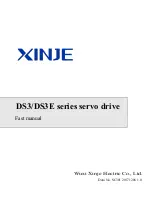
5.4 Advanced Autotuning by Reference (Fn202)
5-33
5
Adjustments
Friction Compensation
This function compensates for changes in the following conditions.
• Changes in the viscous resistance of the lubricant, such as the grease, on the sliding parts of the machine
• Changes in the friction resistance resulting from variations in the machine assembly
• Changes in the friction resistance due to aging
Conditions to which friction compensation is applicable depend on the mode. The friction compensation set-
ting in Pn408.3 applies when the mode is 1. Mode = 2 and Mode = 3 are adjusted with the friction compensa-
tion function regardless of the friction compensation setting in P408.3.
Feedforward
If Pn140 is set to the factory setting and the mode setting is changed to 2 or 3, the feedforward gain (Pn109),
speed feedforward (VFF) input, and torque feedforward (TFF) input will be disabled.
Set Pn140.3 to 1 if model following control is used together with the speed feedforward (VFF) input and
torque feedforward (TFF) input from the host controller.
For the torque feedforward (TFF) input and speed feedforward (VFF) input, refer to the
Σ
-V Series/DC Power
Input
Σ
-V Series/
Σ
-V Series for Large-Capacity Models User’s Manual MECHATROLINK-II Commands
(Manual No.: SIEP S800000 54).
Mode = 1
Mode = 2
Mode = 3
Pn408
n.0
[Factory
setting]
Adjusted without the friction
compensation function
Adjusted with the friction
compensation function
Adjusted with the friction
compensation function
n.1
Adjusted with the friction
compensation function
Mode
Friction
Compensation
Selecting
Parameter
Function
When Enabled Classification
Pn140
n.0
[Factory setting]
Model following control is not used together with the
speed/torque feedforward input.
Immediately
Tuning
n.1
Model following control is used together with the
speed/torque feedforward input.
Model following control is used to make optimum feedforward settings in the SERVO-
PACK when model following control is used with the feedforward function. Therefore,
model following control is not normally used together with either the speed feedforward
(VFF) input or torque feedforward (TFF) input from the host controller. However, model
following control can be used with the speed feedforward (VFF) input or torque feedfor-
ward (TFF) input if required. An improper feedforward input may result in overshooting.
















































